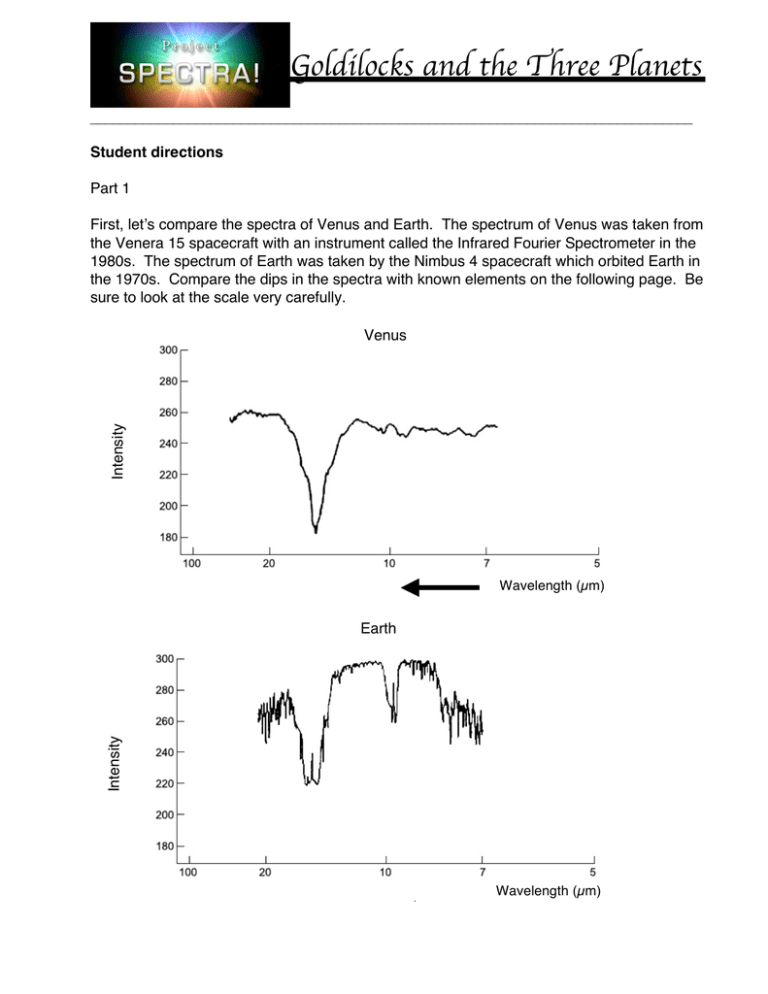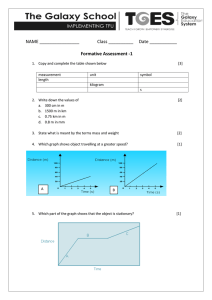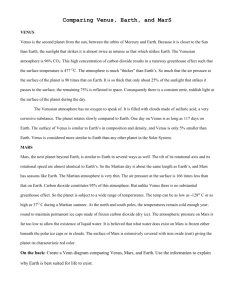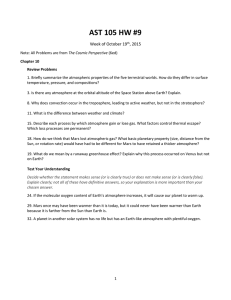________________________________________________________________________________ Part 1
advertisement

________________________________________________________________________________ Student directions Part 1 First, let’s compare the spectra of Venus and Earth. The spectrum of Venus was taken from the Venera 15 spacecraft with an instrument called the Infrared Fourier Spectrometer in the 1980s. The spectrum of Earth was taken by the Nimbus 4 spacecraft which orbited Earth in the 1970s. Compare the dips in the spectra with known elements on the following page. Be sure to look at the scale very carefully. Intensity Venus Wavelength (µm) Intensity Earth Wavelength (µm) ________________________________________________________________________________ ________________________________________________________________________________ 1. Which substances are definitely present in both Earth and Venus’ spectra? 2. Which substances are definitely present in only Earth’s spectrum? 3. Which substances could be present in Earth’s spectrum, but it is difficult to say that they are definitely present? Why? 4. Carbon Dioxide, water, and methane are a few greenhouse gasses. Describe whether or not you see these gasses in the spectra of Venus and Earth. ________________________________________________________________________________ 5. Now, let’s do some math! Venus has 90 times more atmosphere than Earth does. About 97% of the total mass of Venus’ atmosphere is Carbon Dioxide, but only 0.04% of the total mass of Earth’s atmosphere is Carbon Dioxide. a. Write an expression for the amount of Carbon Dioxide in the Earth’s atmosphere using ‘me’ for the mass of Earth’s atmosphere. b. Write an expression for the mass of Venus’ atmosphere using ‘me.’ c. Write an expression for the amount of Carbon Dioxide in Venus’ atmosphere using the expression from part b. d. Compare the amount of Carbon Dioxide in Venus’ atmosphere to the amount in Earth’s atmosphere by dividing the expression from part c by the expression from part a. Round your answer. 6. Using the value from part d above, fill in this blank: Venus has Carbon Dioxide than Earth. times more 7. Venus is very very hot! It can get up to 900 0F at the surface, hot enough to melt lead!! What conjectures can you make about the cause of Venus’ hot temperature? ________________________________________________________________________________ Part 2 Now, let’s look at the spectrum of Mars compared to Earth and Venus. The spectrum of Mars was taken by the Mariner 9 spacecraft in the 1970s. Mars Intensity Venus Earth Wavelength (µm) ________________________________________________________________________________ Put an X in the table below with the substances you know are definitely present. Carbon Monoxide Nitric Oxide Methane Water Ozone Carbon Dioxide Venus Earth Mars 1. Let’s compare Mars and Earth. Mars’ atmosphere is much thinner than Earth’s, about 0.95% of Earth’s atmosphere. About 95% of Mars’ atmosphere is Carbon Dioxide. Remember, only 0.04% of the Earth’s atmosphere is Carbon dioxide. a. Write an expression for the mass of Mars’ atmosphere using ‘me.’ b. Write an expression for the amount of Carbon Dioxide in Mars’ atmosphere using the expression from part a. c. Compare the amount of Carbon Dioxide in Mars’ atmosphere to the amount in Earth’s atmosphere by dividing the expression from part b by the expression from part a from part 1. 2. Using the value from part c above, fill in this blank: Mars has _______ times more Carbon Dioxide than Earth. 3. Even though Mars has more Carbon Dioxide than Earth, it has a much colder average surface temperature of about -70 0F. Clearly, Mars has more Carbon Dioxide than Earth, but much less than Venus. Why do you think Mars’ temperature is so much lower than Earth’s? What factors can affect a planet’s temperature? Brainstorm with a peer.








